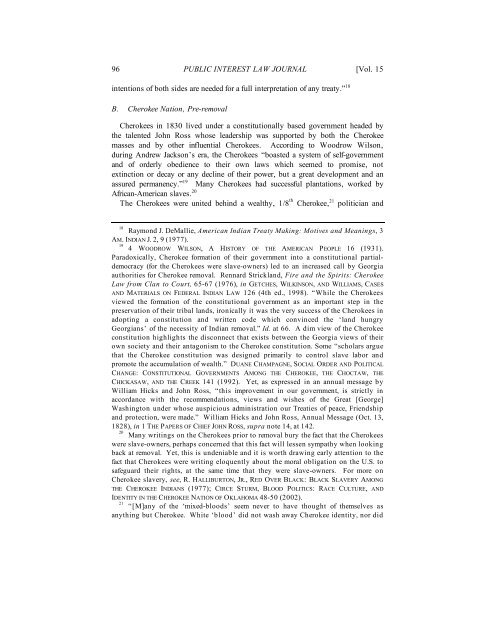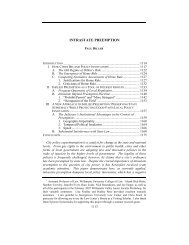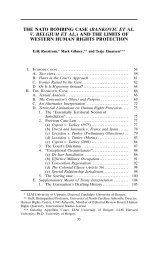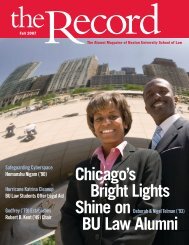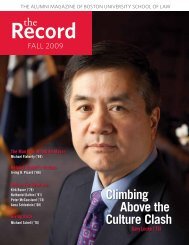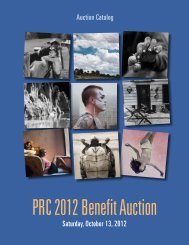the nature of representation: the cherokee right ... - Boston University
the nature of representation: the cherokee right ... - Boston University
the nature of representation: the cherokee right ... - Boston University
You also want an ePaper? Increase the reach of your titles
YUMPU automatically turns print PDFs into web optimized ePapers that Google loves.
96 PUBLIC INTEREST LAW JOURNAL [Vol. 15<br />
intentions <strong>of</strong> both sides are needed for a full interpretation <strong>of</strong> any treaty.” 18<br />
B. Cherokee Nation, Pre-removal<br />
Cherokees in 1830 lived under a constitutionally based government headed by<br />
<strong>the</strong> talented John Ross whose leadership was supported by both <strong>the</strong> Cherokee<br />
masses and by o<strong>the</strong>r influential Cherokees. According to Woodrow Wilson,<br />
during Andrew Jackson’s era, <strong>the</strong> Cherokees “boasted a system <strong>of</strong> self-government<br />
and <strong>of</strong> orderly obedience to <strong>the</strong>ir own laws which seemed to promise, not<br />
extinction or decay or any decline <strong>of</strong> <strong>the</strong>ir power, but a great development and an<br />
assured permanency.” 19 Many Cherokees had successful plantations, worked by<br />
African-American slaves. 20<br />
The Cherokees were united behind a wealthy, 1/8 th Cherokee, 21 politician and<br />
18<br />
Raymond J. DeMallie, American Indian Treaty Making: Motives and Meanings,3<br />
AM.INDIAN J. 2, 9 (1977).<br />
19<br />
4 WOODROW WILSON, A HISTORY OF THE AMERICAN PEOPLE 16 (1931).<br />
Paradoxically, Cherokee formation <strong>of</strong> <strong>the</strong>ir government into a constitutional partialdemocracy<br />
(for <strong>the</strong> Cherokees were slave-owners) led to an increased call by Georgia<br />
authorities for Cherokee removal. Rennard Strickland, Fire and <strong>the</strong> Spirits: Cherokee<br />
Law from Clan to Court, 65-67 (1976), in GETCHES, WILKINSON, AND WILLIAMS, CASES<br />
AND MATERIALS ON FEDERAL INDIAN LAW 126 (4th ed., 1998). “While <strong>the</strong> Cherokees<br />
viewed <strong>the</strong> formation <strong>of</strong> <strong>the</strong> constitutional government as an important step in <strong>the</strong><br />
preservation <strong>of</strong> <strong>the</strong>ir tribal lands, ironically it was <strong>the</strong> very success <strong>of</strong> <strong>the</strong> Cherokees in<br />
adopting a constitution and written code which convinced <strong>the</strong> ‘land hungry<br />
Georgians’ <strong>of</strong> <strong>the</strong> necessity <strong>of</strong> Indian removal.” Id. at 66. A dim view <strong>of</strong> <strong>the</strong> Cherokee<br />
constitution highlights <strong>the</strong> disconnect that exists between <strong>the</strong> Georgia views <strong>of</strong> <strong>the</strong>ir<br />
own society and <strong>the</strong>ir antagonism to <strong>the</strong> Cherokee constitution. Some “scholars argue<br />
that <strong>the</strong> Cherokee constitution was designed primarily to control slave labor and<br />
promote <strong>the</strong> accumulation <strong>of</strong> wealth.” DUANE CHAMPAGNE, SOCIAL ORDER AND POLITICAL<br />
CHANGE: CONSTITUTIONAL GOVERNMENTS AMONG THE CHEROKEE, THE CHOCTAW, THE<br />
CHICKASAW, AND THE CREEK 141 (1992). Yet, as expressed in an annual message by<br />
William Hicks and John Ross, “this improvement in our government, is strictly in<br />
accordance with <strong>the</strong> recommendations, views and wishes <strong>of</strong> <strong>the</strong> Great [George]<br />
Washington under whose auspicious administration our Treaties <strong>of</strong> peace, Friendship<br />
and protection, were made.” William Hicks and John Ross, Annual Message (Oct. 13,<br />
1828), in 1THE PAPERS OF CHIEF JOHN ROSS, supra note 14, at 142.<br />
20<br />
Many writings on <strong>the</strong> Cherokees prior to removal bury <strong>the</strong> fact that <strong>the</strong> Cherokees<br />
were slave-owners, perhaps concerned that this fact will lessen sympathy when looking<br />
back at removal. Yet, this is undeniable and it is worth drawing early attention to <strong>the</strong><br />
fact that Cherokees were writing eloquently about <strong>the</strong> moral obligation on <strong>the</strong> U.S. to<br />
safeguard <strong>the</strong>ir <strong>right</strong>s, at <strong>the</strong> same time that <strong>the</strong>y were slave-owners. For more on<br />
Cherokee slavery, see, R.HALLIBURTON, JR., RED OVER BLACK: BLACK SLAVERY AMONG<br />
THE CHEROKEE INDIANS (1977); CIRCE STURM, BLOOD POLITICS: RACE CULTURE, AND<br />
IDENTITYINTHECHEROKEE NATION OF OKLAHOMA 48-50 (2002).<br />
21<br />
“[M]any <strong>of</strong> <strong>the</strong> ‘mixed-bloods’ seem never to have thought <strong>of</strong> <strong>the</strong>mselves as<br />
anything but Cherokee. White ‘blood’ did not wash away Cherokee identity, nor did


